Updated: 14-Apr-2021
Textron's Lycoming Division is dedicated to the construction of aviation engines, mainly for General Aviation (together with Continental they dominate the current market). And it offers the largest range, in piston engines from its Williamsport facility and for turbines from Stratford.
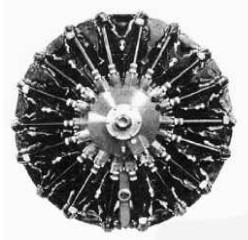
“R-680, with deflectors”
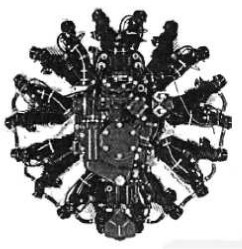
“R-680, without deflectors, rear view”
-It started in 1927 as the genuine Lycoming, in the times of Charles Lindberg, when E.L. Cord, director of Lycoming Manufacturing co., of Williamsport, decided to go into aviation business.
-Shortly after WWII, in 1947, in the AVCO conglomerate and until 1985 the engines were known as AVCO-Lycoming. On this date it is absorbed by Textron and from 1987 the products became known as Textron-Lycoming.
-It is known that in 1994 there were conversations with Allied-Signal, today absorbed by Honeywell.

“Lycoming R-680”
-But going back to the company's beginnings, the first engine was designed in 1928 by engineer Val Cronstadt, it was a 9-cylinder radial, tested on a Stinson and starting with a pre-series of 6 engines.
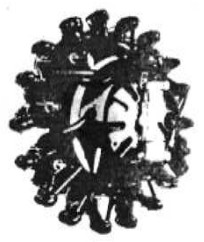
“R-680, half dressed”
-A total of 25,000 engines of this type were built in total, between 215 and 300 hp. The official name was R-680.
-It powered the planes of the first US airlines and favored the popularity of the Beech Travel Air.
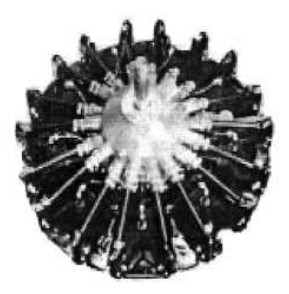
“Another R-680”
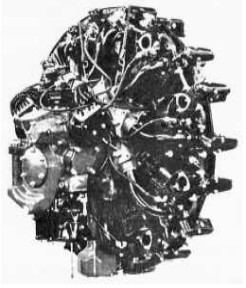
“R-680, angled rear view”

“R-680, cross-section”
-The R-680 took many ATC numbers (42, 81, 108, 110, 111, 172 and 173).
-In 1929 there was a rare radial nine-cylinder R-645 and its power was 185 hp at 1,900 rpm.
-Unknown was the R-500, with 7 radial cylinders giving 145 hp only.
-Later in 1937, another little-known 7-cylinder radial R-530 appeared, based on the R-680s. It gave 190-220 hp.
-The R-530 radial had 7 cylinders and gave 220 hp at 2,300 rpm.
-There were also other series such as R-530-D1, up to D-5.
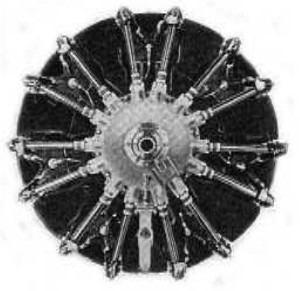
“Lycoming R-530”

“Lycoming R-680”
-We see the Lycoming R-680 with a front exhaust ring, propeller and cone.
-Various series were made. They gave around 220 hp with nine radial cylinders.
-In WWII the R-680 carried out services in trainers, ambulances and artillery guide.

“0-145”
-It is in 1938 when Harold Morehouse (again Morehouse) conceived a horizontally-opposed 4-cylinder engine.

“O-145”
-Initially it gave 55 hp and soon 65 hp. Unlike the rest of the Lycoming engines, it had a top cover on the semi-crankcases.
-It was known as the 0-145, being "O" for Opposed and 145 for the cubic inches of its displacement.
-It soon reaches 75 hp in the O-145C version.
-There was the GO-145 with G for “geared”.
-Firstly the O-145, or horizontally-opposed, air-cooled, 4-cylinder engine, giving 50 hp.
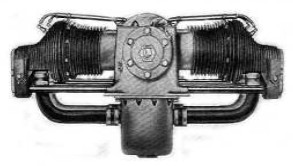
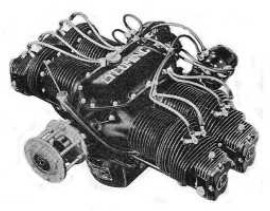
“Lycoming O-145, 50 hp”
-Successive models like the O-145 A-2 increased their power to 55 hp at the same 2,300 maximum rpm.
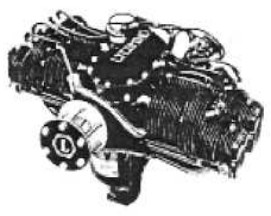
“Lycoming O-145C”
-Below we show new illustrations of the 0-145 engine, but with 75 hp. It has an extended crankshaft at the front and an elongated block as well.
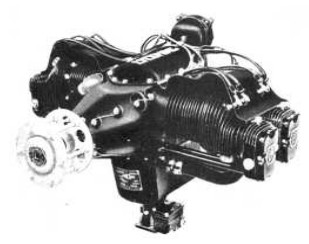
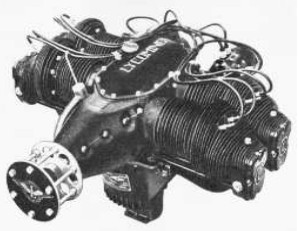
“Dos Lycoming de 75 hp”
-Details such as double ignition can be seen with the spark plugs at the same side in pairs. Usually they are mounted on opposite sides for the best propagation of the ignition.
-The cover over the engine to check crankshaft and connecting rods will disappear in the models of the following years.
-The mixture flow that is directed to the intake ducts, passes through the oil pan. This prevents icing.
-In fact, from this model, Lycoming specializes in horizontally-opposed, 4, 6 and 8 cylinder engines, having the widest range on the market.
-The nomenclature used to distinguish its engines, apart from the displacement in cu. in., was the official US Military and it was:
-O = Opposed cylinders.
- I = Injection.
-V = Vertical engine.
-G = Geared.
-T = Turbo.
-S = Supercharged
-H = Helicopter.
-L = Left hand rotation.
-A = Acrobatic.
-E = Electronics.
-R = Radial.
-X = X-type engine.
-Y = Experimental.
-Every displacement to be mentioned below has had its different combinations with these letters according to their characteristics. The letters after the displacement in Lycoming indicate something else, they are the different adaptations and modifications of each model.
-O-145 and GO-145 series can be -145-A, or -B and -C.
-For example, the GTSIO-360-A1B6D engine means that the engine is one of 360 cubic inches of displacement.
-The cylinders are horizontally opposed, with gear and turbocharger and fuel injection system.
-In the subsequent letters, the first letter A behind the cubicle indicates the type of modification in the rear accessory area.
-The following figure (1) indicates the type of modification of the rear accessory area.
-The following letter is for the design variant of the engine's front part.
-The figure 6 that continues is to indicate the type of counterweights that the crankshaft carries to compensate for vibrations, in this case of the 6th order.
-The last letter D is for the inclusion of "double" magnetos, that is to say that being only one, it is duplicated, in the case of the Bendix D-2000.
-We continue with the description of the Lycoming engines according to the displacement and without entering the variants that exist, and that are mentioned on this page. They are the following.
-A rare engine, unknown for not having seen it commercialized was the O-160, two-cylinder that gave 70/80 hp.
This engine was from the years 1985-86, and it remained at experimental level. Its models were presented in those years in Paris and Oshkosh. On of its features was a rear flywheel for a smooth run.

“O-235”
-The O-235 engine was rated at 100 hp, already with the design of two half crankcases, cylinders, starter ring gear, accessories in the characteristic line of the rest of Lycoming engines, until today.
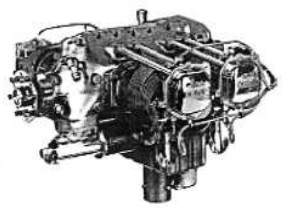
“O-235”
-The O-235B rose to 104 hp. The O-235 was resurrected in the 1980s to power the Cessna-152, Piper Pa-38 Tomahawk, and Beech “Skeeper” two-seater aircraft models.
-Engines with 125 hp were the O-290 (and GO-290, XO-290-, etc.). And versions -A and -C.
-Up to now, the mentioned engines have parallel cylinder valves. Another relevant characteristic is that from these models they would adopt “zero adjustment” hydraulic tappets.
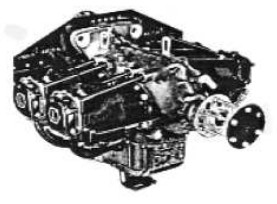
“O-290”
-The same cylinder sizes, but with six of them, are used by the O-435 (A, B and C) and in GO versions as well. The powers are between 190 and 225 hp.
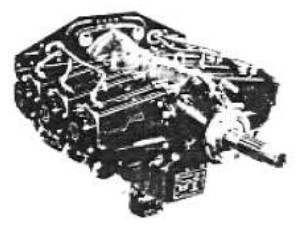
“O-435”
-From the O-435 there is a vertical version used in helicopters that we see below, fully faired (designed by S.K. Hoffman).
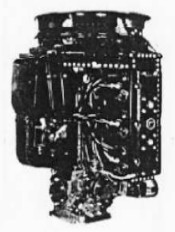
“VO-435 faired”
-The next interesting engine is the O-480 cu. in. that is designed by designer F.W. Ridell.

“GO-480”
-The O-435 has been built under license in some variant in Italy by Piaggio and the GO-480 in Germany by BMW. IGSO, GSO, IGO variants, etc.
-For 270 hp, used in Europe on the Piaggio P-136 and the CASA Do-17.
-The latter one, had inclined valves (trapezoidal rocker covers) and almost hemispherical chambers. It had a delicate epicyclic gearbox with concentric gears of planetariums and satellites.
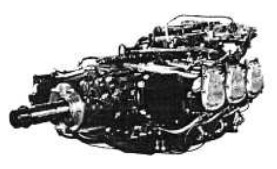
“IGSO-480”
-The formidable IGSO, with injection and mechanical supercharging.
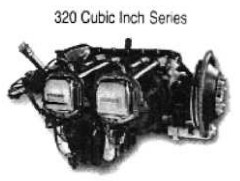
“O-320”
-The O-320 engine, had parallel valves giving powers between 150 and 160 hp. The version with inclined valves and injection gave 200 hp.
-A rare O-340, with 4 horizontally-opposed cylinders giving 160/170 hp at 2,700 rpm was in production between 1954 and 1977. Few aircraft used it, and of these few perhaps the best known was the Twin Navion.
-The VO-340 variant was used on the Brantly B-2 light helicopter prototype.
-Another model for which no application is known was the six-cylinder O-350 that gave 150 hp at 2,500 rpm. The design and construction are similar to the O-435 but with smaller cylinders, those of the O-235.
-The O-360 also had parallel valves, with a nominal power of 180 hp. These widely used engines have been modified or improved by different external review centers such as Mattituck, Penn Yan, Sport Power, Superior Air Parts, etc. Many of these alterations are not approved.
-In the case of Superior Air Parts, they even changed the engine's name becoming Vantage 0-360 (and Vantage IO-360).
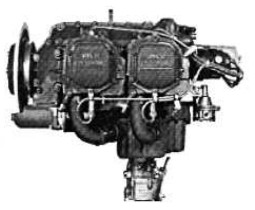
“O-360”
-In addition to the O- and IO- versions, they made the L-, IOL-, VO- IMO- (simple ignition), IVO-, HIO-, LHIO-, HO-, AIO-, TIO, TO-, LTO or AEIO-360.

“IO-360”
-360 cubic inch engines are without a doubt the most prolific engines in general and sports aviation, ideal for 4-seater aircraft.
-The intake ducts in the injection model, due to their shape, are called “Harmonics”, (see above figure).
-The O-365 is very vague. It appears to have been an O-320 that was modified to run on 80 octane, unleaded, and automotive gasoline.
-Another rare engine is the IO-390, with cylinders similar in size to the O-580, but with four of them. It gave 210 hp at 2,700 rpm. There is no carbureted version of this engine, so the O-390 does not exist.
-An AEIO-390 has been prepared for acrobatics. The production is estimated between 2002 to the present, but without known application.
-An O-402 in TIGO version was the head of "High Speed Series" engines.
-They were going to have 4 cylinders for 260-300 hp, the six-cylinder series for 400-450 hp and a possible 8-cylinder series for 570-600 hp. There are no known applications.
-The O-435 and O-480 series have already been treated.
-An engine that is derived from the O-360 is the six-cylinder O-540.
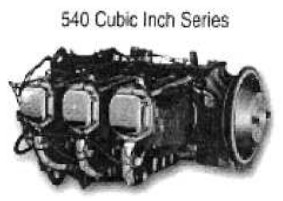
“O-540”
-With powers from 260 hp with carburetor and parallel valves to more than 360 hp in a more complete version (IGSO).
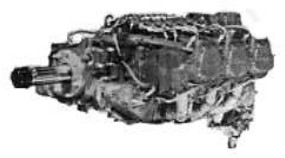
“IGSO-540”
-With injection, gearbox and supercharging. Or the TIO-540, with turbocharger and intercooler.
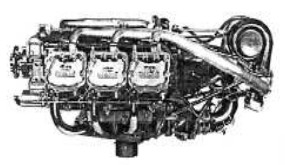
“TIO-540”
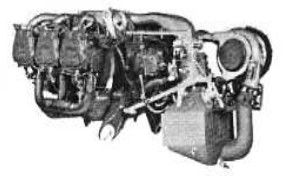
“TIO-540”
-The TIO-541 has an interesting architecture because they invert the air inlet and exhaust gas outlet of the cylinders compared to the basic 0-540.
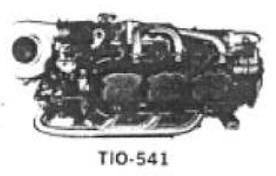
“TIO-541”
-For this, the front air intakes of the fairing are low, entering almost below the propeller. Even more if it is the model with superimposed gear. It gave 425 hp.
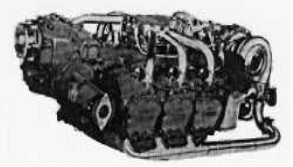
“TIGO-541”
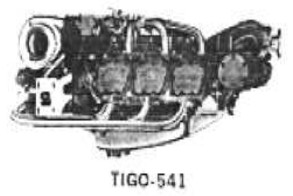
“TIGO-541”
-The O-580s (and GSO, SO or VSO) are eight-cylinders. Much attention because the cylinders were from the O-290, while those of the 6-cylinders were from the O-390 (O-360, O-540, etc.). An eight cylinder illustration is not available. They gave from 320 to 350 hp.
-The six cylinder gives between 310 and 350 hp. The next IO-580 has fuel injection, with no more attachments.
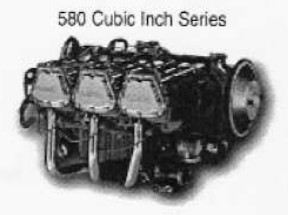
“IO-580”
-From the O-320, -360, -540, -580 acrobatic versions are made preceded by the letters AEIO-580, for example.

“AEIO-580”
-The 720 cubic inch engine, known for its mounting on the Piper Comanche, is a horizontally-opposed, eight-cylinder with carburetor that gives 400 hp.
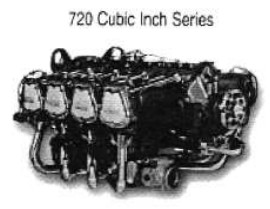
“O-720”
-Or with harmonic intake ducts and injection, in the IO-720.
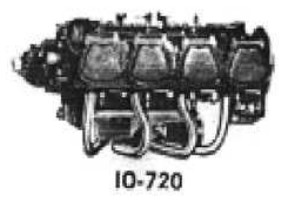
“IO-720”
-There are articles in magazines that mention Lycoming engines with other displacements, commercially unknown, although they may be failed projects, such as the O-233, O-340, R-530-D1 / D2, GSO, SO- and VSO- of the eight-cylinder 580. In any case, information is sought.
-Other interesting engines were those that appeared during WWII, in the shape of an "X" for the Consolidated-Vultee XP-54 and XA-19A, or "H-shape" for the Navy F14C and Vultee V-84.
-But on the subject of horizontally-opposed cylinders, Lycoming would still make a great engine as the O-1230. This engine was designed in the late 1930s, with twelve liquid-cooled cylinders, gearbox, supercharger and carburetor. It gave 1,200 hp.

“O-1230”
-Laterally it took up very little space, so it was suitable to be included within a wing.

“O-1230, front and top view”
-Anyway, the authorities demanded more power, so the O-1230 continued to evolve on the one hand, with the H-formula such as the XH-2460 and XH-2470 and in other projects such as the OL-1430 in addition to the imposing XR-7755.
-A great "polygonal" engine, considered the largest in the world at that time.
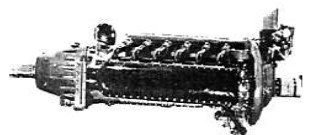

“Dos vistas del O-1230”
-Precisely in the USNA File with the number 3285/452.8, there are some Lycoming entries referring to the Lycoming R-680B4C and a certain X-2460 from the year 1936.
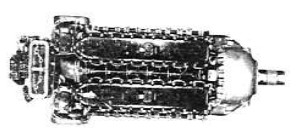
“XH-2470”
-From the union of two superimposed O-1230 engines came the (XH-2360), which was actually XH-2470, remaining experimental and still liquid-cooled. It was intended for 3,000 hp, and its reduction gearbox at the same time had the interconnection gears for the two crankshafts. The program was canceled in 1943.

“XR-7755”
-As stated, the XR-7755 was for a long time the largest and most powerful aviation engine ever made. And it was a Lycoming.
-It was a colossal radial engine of 5,000 hp with four rows of 9 cylinders, 36 injectors with two pumps, and 72 spark plugs with two low voltage magnetos and their distributors.
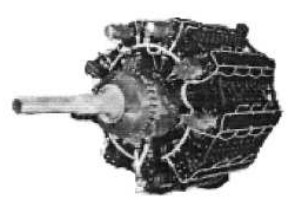
“XR-7755”
-Below we see another view of the same engine, this large engine that consumed 280 gallons per hour (each US gallon is 3,785 liters) and was cooled by liquid that circulated at a rate of 750 gallons per minute.
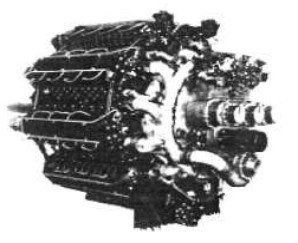
“XR-7755 rear view”
-The history of this engine has a soulless end, because it was destined for the giant B-36 bomber, but political pressure caused the less powerful Pratt & Whitney R-4360 to be installed.

“B-36”
-Four GE J-47 turbojets had to be added to the six Pratt & Whitney mentioned above. It is curious the origin of the B-36, it was raised with the idea of bombing Germany from the US in case the British Isles were lost.
-In Williamsport apart from the piston engines some light turbines like the LT-101 were built, the rest of the turbines were made in Stratford, Connecticutt.
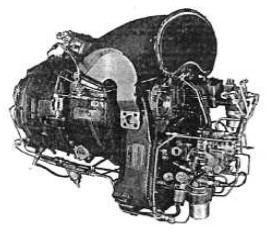
“LT-101”
The LT-101 with 600-shp gave rise to the LTS-101 turboshafts and the LTP-101 turboprops.

“LTS-101-650B”
-The LTS-101-650 are of modular construction, those of the -B series gave 550/590 shp.
-They had a mixed axial-centrifugal compressor, reversed flow annular combustion chamber with 8 injectors and a single-stage turbine for the gas generator, followed by a simple and free turbine called "power-turbine", for the output shaft.

“LTP-101”

“LT-101, seccionada”
-In Stratford, starting in 1951 and with the help of A. Franz, a principal designer of the Junkers Jumo 004, they began to work on the T-53 turboshaft for use in helicopters.
-There have been countless versions of this engine, the L-3, L-9, ... and more than 20,000 engines of this type have been manufactured.
-In addition, under license, they have also been built for their military use, since they can use from commercial diesel diesel to Jet A-1, Jet-B, JP-4, JP-5, JP-8, MIL-T-5624 and ASTM-D1655-70.
Multi-fuel engines serve well for certain frontal aircraft and tanks that go into a country, invading it. While advancing they can use fuel from enemy gas stations on their way and from other fuel tanks.

“LTP-101”
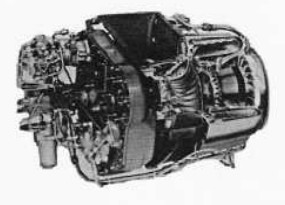
“LT-101, seccionada”
-In addition, they have been built under license by the following companies: Kawasaki, KHD, Piaggio, AIDC.

“T-53 cutaway”
-From the T-53 there have been turboshaft and turboprop versions. They started with low power, 600 shp to reach up to more than 1,800 shp in the latest versions.
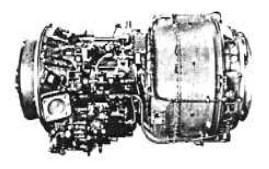

“T-53, turboeje y turbohélice”
-The T-53-13B gave 1,400 shp, the T-53-17A delivered 1,500 shp, the T-53-19A gave 1,800 and the T-53-21A delivered 1,868 shp.
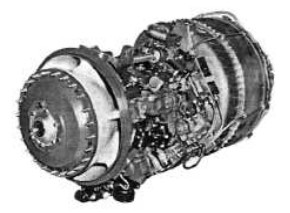
“T-53, foto”
-The T-53s were in turn the LTC-1s, the first is the US Military designation and the latter is Lycoming's own designation.
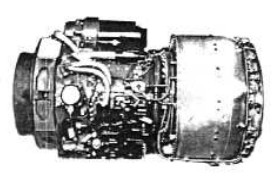
“T-55”
-The T-55s were therefore the LTC-4s. The T-55s were larger than the T-53s and had a power of twice as much or more.
-An example of the aforementioned designations may be that the T-5508D engine corresponds to the LTC4B8D, with 2,250 shp.
-Around 1980 the 3,750 shp or shaft power was already reached by the T-55.

“LTC-4B or T-55”
-The T-5508D mentioned, is an axial flow turbine turboshaft driving a mixed compressor with 7 axial and 1 centrifugal stages.
-It had a reverse flow annular combustion chamber, the same as the T-53. The power turbine is double too.

“T-55, cutaway”
-Now we come to a major Lycoming engine, the ALF-502 turbofan that was launched from 1969.
-The ALF was derived from the “core” of the T-55, adding an important gearbox for the Fan, which is much more than regular in size.
-Civilly known for being used by the BAe 146 (in ALF502 R / L versions) and for being an extremely quiet aircraft, even with its four engines.

“ALF-502”

“ALF502, cutaway”
-Its military variant was YF-102 for the USAF AX program, in 1973.
-In the illustration we see the engine cutaway, and compared to the T-55 in the previous column, the core is identical. We can see the planetary gearbox, the fan well faired, even the built-in oil tank.

“Another ALF-502”

“YF-102”
-Continuing with the turboprops and turboshafts, the advanced PLT-27 delivers 2,000 to 2,500 shp.
-The PLT-27 is the T-405, its military designation.
-The PLT-34 that delivered 800 shp were similar in design to the much more modern LT-101. (Also known by T-405).

“PLT-27”

“PLT-34”
-A derivative of these engines is the one for marine use, the TF-40B.
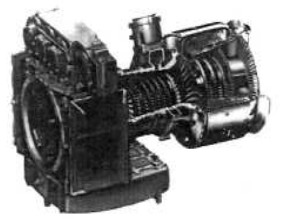
“TF-40B”
-The TF-40B delivers 4,000 shp (4,400 shp intermittent maximum). It is used in Navy air cushion vehicles, therefore they have an output shaft for the maneuver propeller and a compressed air intake to a half compressor to lift the "Hovercraft", as these vehicles are called.


“AGT-1500”
-For use in armored combat tanks there is another derivative of the T-55, which is the AGT-1500. It is selected for the XMI generation of armed vehicles, they give greater mobility and confidence than classic reciprocating engines.
-Finally, to close this chapter of Lycoming, in 1984, there was a collaboration of a Wankel-type engine with the John Deere farm machinery company.

“Lyc. / J. Deere”
-It was presented at the Paris Air Show, it was going to give 200 hp, but in its development, double powers such as 350 to 400 hp were mentioned.
-From that year until today it should have been launched on the market, but at the time of this edition there is no news.
-In the years 2010-11 we know a derivative of the Lycoming IO-580 (583 in cu.) giving 315 hp at 2,700 rpm.

“IO-580”
-It is the Lycoming IO-390-X known as "Specialty engine" to meet market requirements.
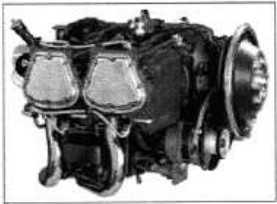
“IO-390-X”
From Appendix 6: A new 115 hp Lycoming engine for light aviation. Based on the well-known O-235.
-It's the O-233-LSA, from Light Sport Aircraft. It can work with Mogas and Avgas. Seen at the 2010 Oshkosh.

“The new Lycoming O-233-LSA”
-With the accumulation of the brand's own experience, this engine is offered lighter in weight as we clearly see through the the starter wheel.
-At the moment it has a carburetor, but it is being tested with gasoline injection.
-On a visit to the Paul Garber space of the Washington Smithsonian Museum (NASM), the Lycoming XH2470-7 could be seen exposed there. Below we show a couple of photos that were taken by a collaborating AEHS member.


“Two views of the XH2470-7”
-Lately we see the spectacular use of the Lycoming T-53 helicopter turboshafts installed on "Tilt" planes, a mix between airplane and helicopter.
-It has the advantages of both. Although the mechanical complication is greater as you can guess.

“T-53, exhaust view”
-The engine installed on these devices must have the capacity to also operate vertically, therefore, the T-53 that equips them is special.
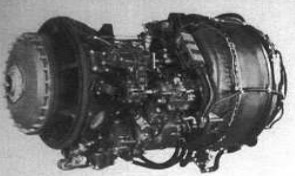
“T-53-L-13”

“T-53-L-13 cutaway”
-Mounting it on a plane requires original mechanisms such as the box for the propeller-rotor (prop-rotor), like shown below.

"Prop-rotor box"

“Vertical cowling position”
-The Bell aircraft on which this propulsion group is destined is the XV-15 model, although it is already operational in some North American helicopter carriers.
-In the two illustrations below we see the horizontal position of the rotors -vertical engines-, and in the forward position with the vertical propellers and the horizontal engines.
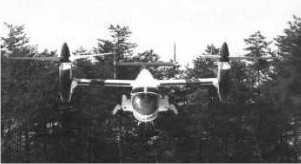
“XV-15 as helicopter”
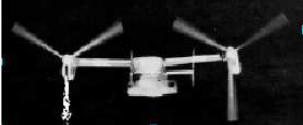
“XV-15 as airplane”
-The idea is not new as we can see in the apparatus of the 1920’s, below.

“Old version of a TILT”

"X3, the current European solution"
-It is said that it was in the 1950’s that Lycoming began to study high bypass ratio turbines, later turbofans, due to their low noise level and lower consumption along with a high thrust on take off.
-The first design was the PLF1A-2, which never flew but started the development of other engines such as the YF102-LD-100 for the Northrop A-9.
-A commercial line of the same engine was installed on the Canadair Challenger CL-600 aircraft and on the BAe-146

“Lycoming PLF1A-2”
-A design from 1964, the PLF1A-2 is a small engine with a diameter of just over 1 meter maximum by 1.7 meters long. It delivered 4,320 lbf of thrust rotating at 1,928 rpm.
-The by-pass ratio was 6 to 1.
We have found an illustration of the Lycoming XH-2470 engine that was developed from the O-1230.
-A curious information tells us that it is the coupling of two engines of the latter type in "H" configuration, but that instead of maintaining two crankshafts, it only had one for its 24 cylinders.
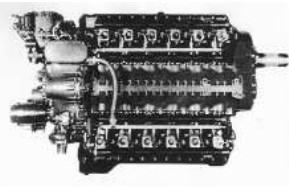
“XH-2470, con reductora”
-And now, information from the year 1949 in which the appearance of the Beechcraft Model 34 "Twin Quad" aircraft was published. Unknown to most of us in the world of aviation.
-It was a large size aircraft that had a Bonanza type V-tail.

“Beech Twin-Quad”
-The design began in 1943. But the interesting thing is that due to the lack of power in light aviation engines, it was decided to mount twin engines.
-This happened with other brands such as Bristol (for the Brabazón, etc.) and not only with piston engines but also with the first underpowered turbines.
-The two twin engines were installed in a peculiar position, on the leading edge of the wing on both sides of the propeller shaft and with a very interesting gearbox with clutches.

“Installation on a Beech 34”
-As we can see, the engines are transverse, perhaps the only arrangement of this kind that has been seen. The engines were Lycoming GSO-580s but beware, in the history of Lycoming there are two types of O-580 engines: those from the early period, the eight-cylinder engines (see main text), and the more modern 6-cylinder engines.
-In the case of the Twin-Quad they were the eight horizontally-opposed cylinders. The cooling is laterally as we see from the air intakes in the photo below.
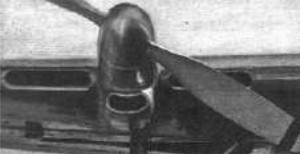
“Powertrain front view”
-Naturally if one engine failed a freewheel clutch system isolated that engine and operation was continued with the other.
The well-known ALF-502 turbofan, interesting for being quiet, clean and economical, had an ancestor in the ALF-301.
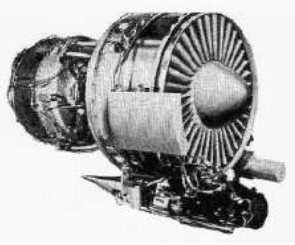
“AVCO-Lycoming ALF-301”
-And a rear view of the ALF-502, with high bypass ratio. It uses the core of the T-55.
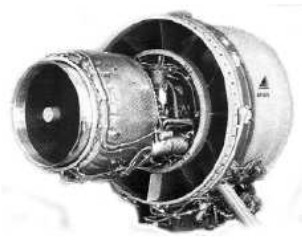
“ALF-502 rear view”
-Recently I have been informed about the Lycoming piston O-390 version, derived from the O-360, which when running on the new 91/96 UL gasoline, had a slight decrease in power. This is recovered with 30 cu. in. in displacement.
-Below we show a curious photograph; the breaking-in of the engines at the factory exit before delivery. Curiously, the break-in is carried out by electric motors and not by its own operation.
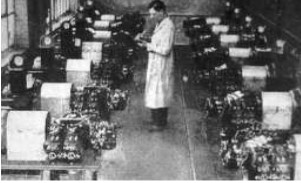
“Break-in hall” (PiP)
-We also show the Lycoming with 12 horizontally-opposed cylinders that was to be installed inside the wings. It gave 1,200 hp. In the main text it appears in a drawing, now it is a real photo.
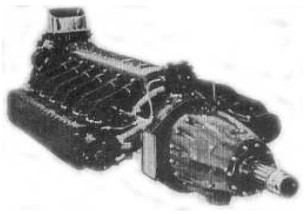
“The engine known as Pancake” (PiP)
-It is liquid cooled.
-New view of the IO-233 for LSA. Made on the basis of the 0-235. It also gives 115 hp at 2,800 rpm. It has gasoline injection.
-Like most modern or relieved compression Lycoming engines, they can have the TBO at 2,400 Hrs.
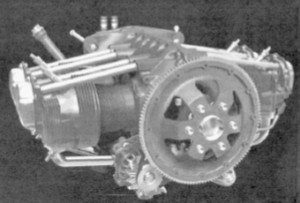
“Lycoming IO-233”
-A curiosity: like Continental - its great competitor - Lycoming also made automotive engines.
-In April 2012, the author discovered at the Safran Museum (France) and in their restoration workshops some “Benevolent Friends” restoring a Gnome-Rhone car with an in-line 8-cylinder Lycoming engine.
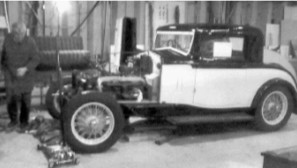
“Car with a non-aero Lycoming engine”
From Appendix 9: Information from Aviation News: A helicopter turbine T-53 turboshaft has been adapted by Composites Air Inc. to be used, through modifications, as a turboprop on one of its hydroplanes.
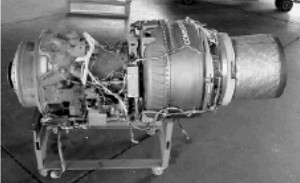
“T-53 from turboshaft to turboprop” (PiP)
-A new 75 hp is also available, although with several mutilated small parts such as the oil plug, ramps, and others.
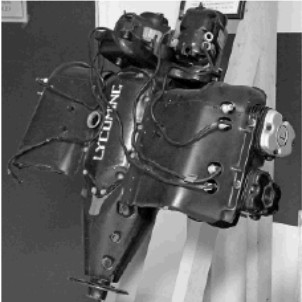
"Lycoming 75 hp Originally Exposed" (PiP)
-A new small three-cylinder, multi-fuel engine has been put on the market by this North American brand. Special for UAV.

“Lycoming 3-cylinder side view”
-It is the EL-060 model. Here are some other views for this unusual engine.

“A shocking front view”
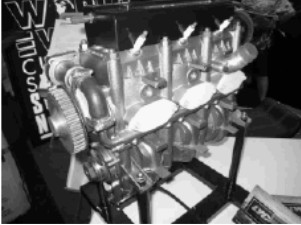
“Lycoming LE-060 side view”
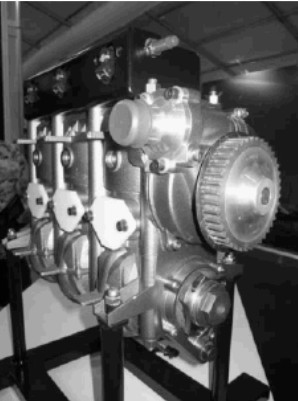
“Lycoming EL-060, water pump side”
-This engine gives 63 hp at 6,000 rpm.
From Appendix 10: With the new times of unleaded fuels due to environmental directives and the proliferation of engines running on Diesel but consuming Jet-A1 readily available at all airports, Lycoming (AVCO-Textron Lycoming) has released its latest product the TED-540.
-The O-233 model is the case of using UL (Un-Leaded) fuels, including automotive gasoline, e.g. 95 N.O.
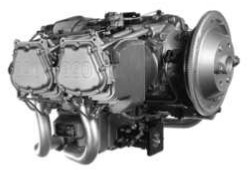
“Lycoming O-390, first of the Thunderbolt series”

“The TED-540 presented in 2015”
-The two engines shown here have inclined valves. See trapezoidal rocker covers.
From Appendix 12: (From the AVCO / Textron Group). New engines appear in the 2016 Catalog, highlighting the YIO-233, AEIO-580, IO-390. and the "iE-2" in particular.

“Lycoming IO-390, 4-cylinder”
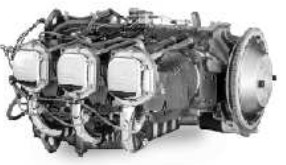
“Lycoming IO-540, 6-cylinder”
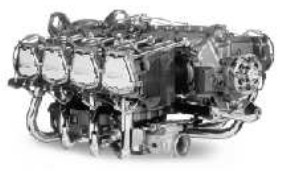
“Lycoming IO-720, 8-cylinder”

"Lycoming AEIO-580, with special version -Thunderbolt- for Red-Bull"

“Lycoming YIO-233”
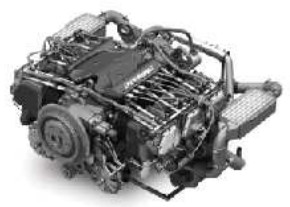
“Lycoming “iE-2” 6-cylinder with electronics”
-This large aviation engine company for AV-GEN has entered the drone market by making a small Lycoming single-cylinder engine giving 4 hp at 5,000 rpm. The EL-005 model.


“From the catalog”
-It is very interesting that it can run on JP-5, JP-8, Jet-A, Jet-A1, F-24, Mogas, Avgas, UL. It has HFE technology, Heavy Fuel Engines. And Multifuel.
From Appendix 13: New view of the exceptional XR-7755 engine that was intended for the B-36 bomber and whose soulless information is discussed in the main text.

“Lycoming XR-7755”
-The 2017 version of the IO-390 is being presented at Sun-n-fun, AERO Friedrichshafen, Alaska Aviation Gathering, etc.
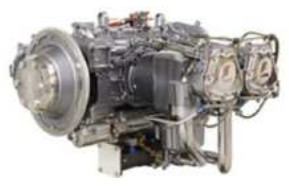
“Lycoming IO-390, with gasoline injection”
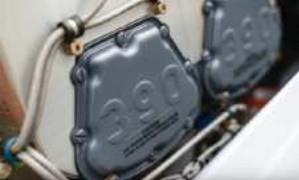
“Rocker Box Covers”
-Curiously, unlike other models, it has engraved on each cover the "390" cu. in. of displacement. It gives the impression of wanting to replace the successful IO-360.
-It uses trapezoidal covers for having inclined valves. Besides it has an almost hemispherical chamber with more compression ratio.
-And another photo of the O-233-LSA.

“With a lighter flywheel”
-Maybe due to the reduction of the General Aviation market, the company specializes in offering engines tailored to the client. There appear engine lines or series such as the Thunderbolt, Signature, Extreme and Competition.
-You can propose your need, the performances you want, even the engine's color.
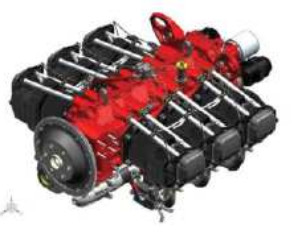
“Lycoming, 540 cu-in., Thunderbolt”
-The red Thunderbolt in the illustration above is a gasoline-injected IO-540.
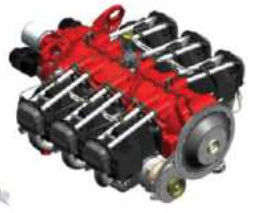
“The same engine as above seen from the other side”

“Lycoming with advanced devices”

“Lancair aircraft with special Lycoming engine”
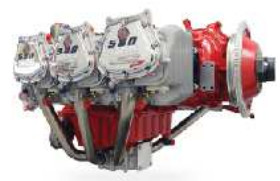
“Lycoming iE2 Engine Powers on Lancair”
-The iE2 has electronic injection and ignition with an advanced Fadec, called “Computer Logic Control Electgronic”. It can use AVGAS 100LL and 100UL gasoline.

"A new brand logo has appeared"
Engines of LYCOMING
Model: AGT-1500
Arquitecture:
Compressor/s:
Combustion chambers:
Turbines:
Power / Thrust:
Weight:

"Lycoming AGT-1500, fig. 2"
Model: AL-55
Arquitecture:
Cooling:
Total Displacement:
Bore / Stroke: x
Power:
Weight:
Model: ALF-101
Arquitecture:
Compressor/s:
Combustion chambers:
Turbines:
Power / Thrust:
Weight:
Model: ALF-301
Arquitecture:
Compressor/s:
Combustion chambers:
Turbines:
Power / Thrust:
Weight:

"AVCO-Lycoming ALF-301"
Model: ALF-502
Arquitecture: Turbofan
Compressor/s:
Combustion chambers:
Turbines:
Power / Thrust:
Weight:

"Lycoming, ALF502"
Model: ”Pancake” (12 cils. boxer)
Arquitecture:
Cooling:
Total Displacement:
Bore / Stroke: x
Power:
Weight:

"Lycoming, the engine known as Pancake"
Model: Competition series
Arquitecture:
Cooling:
Total Displacement:
Bore / Stroke: x
Power:
Weight:
Model: EL-005
Arquitecture: 2-stroke Single-cylinder
Cooling: Air
Total Displacement: 75 cc
Bore / Stroke: 49 x 40
Power: 4 HP @ 5500 rpm
Weight: 14 Lb

"Lycoming, EL-005"
Model: EL-060
Arquitecture:
Cooling:
Total Displacement:
Bore / Stroke: x
Power:
Weight:

"Lycoming, EL-060, angled side view"
Model: Extreme series
Arquitecture:
Cooling:
Total Displacement:
Bore / Stroke: x
Power:
Weight:
Model: F-102
Arquitecture:
Cooling:
Total Displacement:
Bore / Stroke: x
Power:
Weight:

"Lycoming, YF-102"
Model: F-106
Arquitecture:
Cooling:
Total Displacement:
Bore / Stroke: x
Power:
Weight:
Model: F-408 (ver CAE-382)
Arquitecture:
Cooling:
Total Displacement:
Bore / Stroke: x
Power:
Weight:
Model: GSO-580, SO-, VSO-
Arquitecture: 8-cylinder Horizontally opposed
Cooling: Air
Total Displacement: 580 cu. in.
Bore / Stroke:
Power: 375 HP @ 3300 rpm
Weight:
Model: iE-2
Arquitecture:
Cooling:
Total Displacement:
Bore / Stroke: x
Power:
Weight:

"Lycoming iE2 Engine Powers on Lancair"
Model: IO-390, AEIO-390
Arquitecture: 4-cylinder Horizontally opposed
Cooling:
Total Displacement:
Bore / Stroke:
Power: 210 HP @ 2700 rpm
Weight:

"Lycoming O-390, first of the Thunderbolt series"
Model: IO-520
Arquitecture:
Cooling:
Total Displacement:
Bore / Stroke: x
Power:
Weight:
Model: IO-580,-, AEIO,
Arquitecture: 6-cylinder Horizontally opposed
Cooling: Air
Total Displacement: 580 cu. in.
Bore / Stroke:
Power: 300 HP @ 2500 rpm
Weight:

"Lycoming, IO-580 fig. 2"
Model: IO-720, TIO-
Arquitecture: 8-cylinder Horizontally opposed
Cooling: Air
Total Displacement: 720 cu. in.
Bore / Stroke:
Power: 400 HP @ 2650 rpm
Weight: 597 Lb

"Lycoming IO-720, 8-cylinder"
Model: J-402 (ver CAE-370 series)
Arquitecture:
Cooling:
Total Displacement:
Bore / Stroke: x
Power:
Weight:
Model: John-Deere/Lyc. rotary
Arquitecture:
Cooling:
Total Displacement:
Bore / Stroke: x
Power:
Weight:

"Lycoming, Lyc. / J. Deere"
Model: LF-507
Arquitecture:
Compressor/s:
Combustion chambers:
Turbines:
Power / Thrust:
Weight:
Model: LT-101
Arquitecture: Turboshaft
Compressor/s: 1 axial LP stage and 1 centrigugal HP stage
Combustion chambers: Annular chamber
Turbines: 1 HP stage and 1 LP stage
Power / Thrust: 600SHP / ---
Weight:

"Lycoming, LT-101, cutaway"
Model: LTC-1
Arquitecture:
Compressor/s:
Combustion chambers:
Turbines:
Power / Thrust:
Weight:
Model: LTC-4
Arquitecture:
Compressor/s:
Combustion chambers:
Turbines:
Power / Thrust:
Weight:
Model: LTP-101
Arquitecture: Turboprop
Compressor/s: 1 axial LP stage and 1 centrigugal HP stage
Combustion chambers: Annular chamber
Turbines: 1 HP stage and 1 LP stage
Power / Thrust: 600SHP / ---
Weight:
LTP101-600: 600 SHP
LTP101-700: 700 SHP

"Lycoming, LTP-101"
Model: LTS-101
Arquitecture: Turboshaft
Compressor/s: 1 axial LP stage and 1 centrigugal HP stage
Combustion chambers: Annular chamber
Turbines: 1 HP stage and 1 LP stage
Power / Thrust: 650 / ---
Weight:
Powers vary between models between 650 SHP and 850SHP.

"Lycoming, LTS-101-650B"
Model: O-1230
Arquitecture: 12-cylinder Horizontally opposed
Cooling: Liquid
Total Displacement: 1230
Bore / Stroke:
Power: 1200 HP @ 3400 rpm
Weight:

"Lycoming, O-1230 angled front view"
Model: O-145, GO-
Arquitecture: 4-cylinder Horizontally opposed
Cooling: Air
Total Displacement: 145 cu. in.
Bore / Stroke:
Power: 65 HP @ 2300 rpm
Weight:

"Lycoming, O-145 angled front view"
Model: O-160
Arquitecture: 2-cylinder Horizontally opposed
Cooling:
Total Displacement: 160 cu. in.
Bore / Stroke:
Power: 80 HP
Weight:
Model: O-233-LSA, IO-233 (base 0-235), YIO-,
Arquitecture:
Cooling:
Total Displacement:
Bore / Stroke: x
Power:
Weight:

"Lycoming YIO-233"
Model: O-235
Arquitecture: 4-cylinder Horizontally opposed
Cooling:
Total Displacement:
Bore / Stroke:
Power: 100 HP
Weight:

"Lycoming O-235, angled front view"
Model: O-290, GO-
Arquitecture: 4-cylinder Horizontally opposed
Cooling:
Total Displacement: 290 cu. in.
Bore / Stroke:
Power: 125 HP
Weight:

"Lycoming, O-290"
Model: O-320
Arquitecture: 4-cylinder Horizontally opposed
Cooling: Air
Total Displacement: 320 cu. in.
Bore / Stroke:
Power: 160 HP
Weight:

"Lycoming, O-320"
Model: O-340
Arquitecture: 4-cylinder Horizontally opposed
Cooling:
Total Displacement: 340 cu. in.
Bore / Stroke:
Power: 170 @ 2700 rpm
Weight:
Model: O-350
Arquitecture: 6-cylinder Horizontally opposed
Cooling:
Total Displacement:
Bore / Stroke:
Power: 150 HP @ 2500 rpm
Weight:
Model: O-360, IO-, HIO-, TIO-, AEIO-
Arquitecture: 4-cylinder Horizontally opposed
Cooling: Air
Total Displacement: 360 cu. in.
Bore / Stroke:
Power: 180 HP @ 2700 rpm
Weight:

"Lycoming, IO-360"
Model: O-365 (experimental)
Arquitecture: 4-cylinder Horizontally opposed
Cooling:
Total Displacement: 365 cu. in.
Bore / Stroke:
Power:
Weight:
Experimental engine. It appears to have been an O-320 that was modified to run on 80 octane, unleaded, and automotive gasoline.
Model: O-435, GO-, VO-
Arquitecture: 6-cylinder Horizontally opposed
Cooling: Air
Total Displacement: 435 cu. in.
Bore / Stroke:
Power: 225 HP
Weight: 433 Lb

"Lycoming, O-435"
Model: O-480, GO-
Arquitecture: 6-cylinder Horizontally opposed
Cooling: Air
Total Displacement: 480 cu. in.
Bore / Stroke:
Power: 270 HP
Weight:

"Lycoming, IGSO-480"
Model: O-530, AEIO-,
Arquitecture:
Cooling:
Total Displacement:
Bore / Stroke: x
Power:
Weight:
Model: O-540, IO-, TSIO-, AEIO-, IGSO
Arquitecture: 6-cylinder Horizontally opposed
Cooling:
Total Displacement: 540 cu. in.
Bore / Stroke:
Power: 260 HP @ 2700 rpm
Weight:

"Lycoming IO-540, 6-cylinder"
Model: PLF-1A-2
Arquitecture:
Compressor/s:
Combustion chambers:
Turbines:
Power / Thrust:
Weight:

"Lycoming PLF1A-2"
Model: PLT-27 (T-702)
Arquitecture:
Compressor/s:
Combustion chambers:
Turbines:
Power / Thrust:
Weight:

"Lycoming, PLT-27"
Model: PLT-34
Arquitecture:
Compressor/s:
Combustion chambers:
Turbines:
Power / Thrust:
Weight:

"Lycoming, PLT-34"
Model: R-500
Arquitecture: 7-cylinder Radial
Cooling:
Total Displacement:
Bore / Stroke:
Power: 145 HP
Weight:
Model: R-530
Arquitecture: 7-cylinder Radial
Cooling:
Total Displacement:
Bore / Stroke:
Power: 220 HP @ 2300 rpm
Weight:

"Lycoming R-530"
Model: R-645
Arquitecture: 9-cylinder Radial
Cooling:
Total Displacement:
Bore / Stroke:
Power: 185 HP @ 1900 rpm
Weight:
Model: R.680
Arquitecture: 9-cylinder Radial
Cooling:
Total Displacement: 680 cu. in.
Bore / Stroke:
Power: 220 HP
Weight:

"Lycoming R-680"
Model: Signature series
Arquitecture:
Cooling:
Total Displacement:
Bore / Stroke: x
Power:
Weight:
Model: T-53 (LTC-1)
Arquitecture: Turboshaft
Compressor/s: 5 axial stages, 1 centrifugal stage
Combustion chambers: Reverse flow
Turbines: 2 HP stages and 1 LP stage
Power / Thrust: 1451SHP / ---
Weight:
Powers vary according to model between 860 SHP and 1800 SHP.

"Lycoming, T-53, photo"
Model: T-55 (LTC-4)
Arquitecture: Turboshaft
Compressor/s: 7 axial stages, 1 centrifugal stage
Combustion chambers: Reverse flow
Turbines: 2 gas generating stages, 2 free power stages
Power / Thrust:
Weight:
Powers vary according to model between 1651 shp and 6500 shp.

"Lycoming, T-55, cutaway"
Model: T-702
Arquitecture:
Compressor/s:
Combustion chambers:
Turbines:
Power / Thrust:
Weight:
Model: TED-540
Arquitecture:
Cooling:
Total Displacement:
Bore / Stroke: x
Power:
Weight:

"Lycoming, TED-540 presented in 2015"
Model: Thunderbolt series
Arquitecture:
Cooling:
Total Displacement:
Bore / Stroke: x
Power:
Weight:
Model: TIGO-402-A1A
Arquitecture: 6-cylinder Horizontally opposed
Cooling:
Total Displacement: 402 cu. in.
Bore / Stroke:
Power: 450 HP
Weight:
Not entered into production
Model: TIO-541, TIGO-
Arquitecture: 6-cylinder Horizontally opposed
Cooling: Air
Total Displacement: 541 cu. in.
Bore / Stroke:
Power: 310 @ 2575 rpm
Weight:
Powers according to model from 310 hp (TIO-541-A1A) to 450 hp (TIGO versions -B1A, D1A, -D1B y -G1AD)

"Lycoming, TIGO-541"
Model: XH-2360 (XH2470)
Arquitecture:
Cooling:
Total Displacement:
Bore / Stroke:
Power:
Weight:
Model: XH-2470 (XH-2360)
Arquitecture: 24-cylinder H-Engine
Cooling: Liquid
Total Displacement: 2468 cu. in.
Bore / Stroke:
Power: 3000 @ rpm
Weight:

"Lycoming XH2470-7, fig. 2"
Model: XR-7755
Arquitecture: 36-cylinder Radial
Cooling: Liquid
Total Displacement: 7750 cu. in.
Bore / Stroke:
Power: 5000 HP @ 2600 rpm
Weight:

"Lycoming, XR-7755 angled front view"


